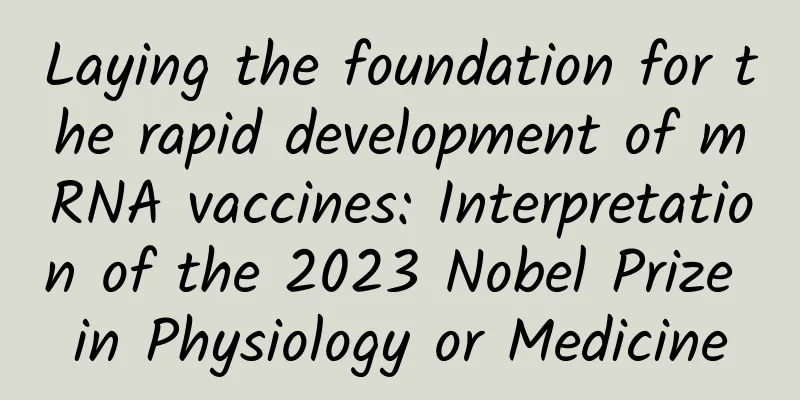Laying the foundation for the rapid development of mRNA vaccines: Interpretation of the 2023 Nobel Prize in Physiology or Medicine

|
Xinhua News Agency, Beijing, October 2 (Reporter Luo Guofang) The Karolinska Institute in Sweden announced on the 2nd that the 2023 Nobel Prize in Physiology or Medicine will be awarded to Katalin Kouriko and Drew Weissman in recognition of their groundbreaking discoveries in messenger ribonucleic acid (mRNA) research. These discoveries have helped vaccine development to reach an unprecedented speed. Vaccination stimulates the body to form an immune response against a specific pathogen, allowing the body to "take the lead" in gaining immunity when it is exposed to the pathogen in the future. The earliest vaccines were based on inactivated or weakened viruses, such as polio, measles and yellow fever vaccines. With the advancement of molecular biology, vaccines based on partial components of viruses rather than whole viruses have gradually been developed. However, viruses rely on body cells to replicate, and vaccines based on whole viruses, viral proteins, and viral vectors all require large-scale cell culture. When certain infectious diseases break out, rapid production of vaccines requires intensive investment in cell culture. Therefore, researchers have long been trying to develop vaccine technology independent of cell culture, but this process is fraught with difficulties. In the body's cells, genetic information exists in the form of deoxyribonucleic acid (DNA) codes, but the DNA codes need to be transcribed into mRNA, and then proteins are produced using mRNA as a "template". In the 1980s, an effective method for producing mRNA without cell culture was developed, known as in vitro transcription. This has accelerated the development of molecular biology applications in many fields. Using mRNA for vaccines and therapeutic purposes has also become an option. However, in vitro transcribed mRNA is considered unstable and difficult to deliver, requiring the development of complex lipid carrier systems to "encapsulate" mRNA fragments, and can also trigger inflammatory responses, which greatly limits its prospects for clinical application. At the beginning of this century, while collaborating at the University of Pennsylvania, Kauricco and Weissman noticed that the body's immune system's dendritic cells would recognize in vitro transcribed mRNA as foreign, causing it to activate and release inflammatory signaling molecules. Why would in vitro transcribed mRNA be recognized as foreign, while mRNA from mammalian cells did not cause the same reaction? Kauricco and Weissman realized that there must be some key features that distinguish different types of mRNA. They noticed that the genetic information carried by mRNA is not just the four bases A, U, C, and G, but also includes a variety of chemical modifications. The bases in mammalian cell RNA (ribonucleic acid) are often chemically modified, while in vitro transcribed mRNA does not have these chemical modifications. Is it this base modification that causes the difference? To test this idea, they produced different mRNA variants, each with a unique chemical modification to the bases, and delivered them to dendritic cells. The results were stunning: When the mRNA contained the base modifications, the inflammatory response was virtually eliminated. This groundbreaking research result was published in 2005. In further research, Kauric and Weissman found that the delivery of mRNA generated by base modification significantly increased protein production compared to unmodified mRNA. This effect is due to the reduced activity of enzymes that regulate protein production. By discovering that base modification can both reduce inflammatory responses and increase protein production, Kauric and Weissman eliminated a key obstacle on the road to clinical application of mRNA technology. Since then, mRNA vaccines for Zika virus and Middle East respiratory syndrome coronavirus have been developed based on this technology; after the outbreak of the new crown epidemic, two base-modified mRNA vaccines encoding the surface protein of the new coronavirus were developed at a record speed. The flexibility and speed of mRNA vaccine development are impressive, paving the way for the use of new platforms to develop vaccines for other infectious diseases. In the future, this technology can also be used to deliver therapeutic proteins and treat certain types of cancer. |
<<: How do Apple devices greet each other? - An interesting talk about the Bonjour protocol
>>: Local temperature drops by more than 10℃! A new wave of cold air is coming
Recommend
Does Xiatare Tablets contain hormones?
Baixuan Xiatare Tablets are made of imported Sica...
The efficacy and function of Hackberry bark
Hackberry bark is a very common Chinese medicine....
How painful is it when that thing grows into your flesh?
One minute with the doctor, the postures are cons...
German Chamomile
The hot summer is coming, and during this period ...
The efficacy and function of boxwood leaves
Boxwood leaf is a very common Chinese medicine an...
The "time bomb" hidden in the body! Can you tell whether your blood vessels are healthy by touching the instep?
Expert of this article: Chen Sijiao, chief physic...
The efficacy and function of Hong Kong four-orange fruit
The Chinese medicine Hong Kong Oleander is often ...
Can eating Poria cocos whiten your skin?
People are familiar with a lot of Chinese medicin...
PricewaterhouseCoopers: Survey shows 93% of Malaysians have online shopping experience
“Southeast Asian consumers have emerged as the wo...
8D Magic Chongqing: Our reputation as the “City of Bridges” is well deserved!
Chongqing, as one of the top ten popular tourist ...
Please fill in the blank: Eat meat but not garlic, ___________
Audit expert: Wang Guoyi Postdoctoral fellow in N...
1056 seconds! China's "artificial sun" EAST sets a new record for the longest discharge
On the evening of December 30, 2021, the world re...
Zhu Kezhen and Hu Shi's "Gamble" on Health
Master's Past The seventh of this month marks...
The efficacy and function of false spinach
Many people choose fake spinach because of its hi...
The efficacy and function of Boletus edulis
Boletus is a kind of Chinese medicinal material w...









